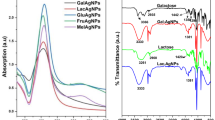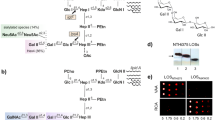Abstract
Polyvalent carbohydrate-protein interactions play a key role in bio- and pathological processes, including cell-cell communication and pathogen invasion. In order to study, control and manipulate these interactions gold nanoparticles have been employed as a 3D scaffold, presenting carbohydrate ligands in a multivalent fashion for use as high affinity binding partners and a model system for oligosaccharide presentation at biomacromolecular surfaces. In this study, the binding of a series of mannose-functionalised gold nanoparticles to the dimeric BC2L-A lectin from Burkholderia cenocepacia has been evaluated. BC2L-A is known to exhibit a high specificity for (oligo)mannosides. Due to the unique structure and binding nature of this lectin, it provides a useful tool to study (oligo)saccharides presented on multivalent scaffolds. Surface plasmon resonance and isothermal titration calorimetric assays were used to investigate the effect of ligand presentation density towards binding to the bacterial lectin. We show how a combination of structural complementarities between ligand presentation and lectin architecture and statistical re-binding effects are important for increasing the avidity of multivalent ligands for recognition by their protein receptors; further demonstrating the application of glyconanotechnology towards fundamental glycobiology research as well as a potential towards biomedical diagnostics and therapeutic treatments.





Similar content being viewed by others
References
Lis, H., Sharon, N.: Lectins: carbohydrate-specific proteins that mediate cellular recognition. Chem. Rev. 98, 637–674 (1998)
Varki, A., Cummings, R.D., Esko, J.D., Freeze, H.H., Stanley, P., Bertozzi, C.R., Hart, G.W., Etzler, M.E.: Essentials of Glycobiology, 2nd edn. Cold Spring Harbour, New York (2009)
Kramer, R.H., Karpen, J.W.: Spanning binding sites on allosteric proteins with polymer-linked ligand dimers. Nature 395, 710–713 (1998)
Gargano, J.M., Ngo, T., Kim, J.Y., Acheson, D.W., Lees, W.J.: Multivalent inhibition of AB(5) toxins. J. Am. Chem. Soc. 123, 12909–12910 (2001)
Mammen, M., Choi, S.K., Whitesides, G.M.: Polyvalent interactions in biological systems: Implications for design and use of multivalent ligands and inhibitors. Angew. Chem. Int. Ed. 37, 2755–2794 (1998)
Reynolds, M., Perez, S.: Thermodynamics and chemical characterization of protein-carbohydrate interactions: the multivalency issue. C. R. Chim. 14, 74–95 (2011)
Bernardi, A., Jimenez-Barbero, J., Casnati, A., De Castro, C., Darbre, T., Fieschi, F., Finne, J., Funken, H., Jaeger, K.E., Lahmann, M., Lindhorst, T.K., Marradi, M., Messner, P., Molinaro, A., Murphy, P.V., Nativi, C., Oscarson, S., Penadés, S., Peri, F., Pieters, R.J., Renaudet, O., Reymond, J.L., Richichi, B., Rojo, J., Sansone, F., Schaffer, C., Turnbull, W.B., Velasco-Torrijos, T., Vidal, S., Vincent, S., Wennekes, T., Zuilhof, H., Imberty, A.: Multivalent glycoconjugates as anti-pathogenic agents. Chem. Soc. Rev. (2013). doi:10.1039/C2CS35408J
Marradi, M., Chiodo, F., Garcia, I., Penadés, S.: Glyconanoparticles as multifunctional and multimodal carbohydrate systems. Chem. Soc. Rev. (2013). doi:10.1039/C2CS35420A
Tvaroska, I., Sihelnikova, L.: Step by step towards understanding gold glyconanoparticles as elements of the nanoworld. Chem. Pap. 61, 237–255 (2007)
Marradi, M., Martin-Lomas, M., Penadés, S.: Glyconanoparticles polyvalent tools to study carbohydrate-based interactions. Adv. Carbohyd. Chem. Biochem. 64, 211–290 (2010)
Boisselier, E., Astruc, D.: Gold nanoparticles in nanomedicine: preparations, imaging, diagnostics, therapies and toxicity. Chem. Soc. Rev. 38, 1759–1782 (2009)
Otsuka, H., Akiyama, Y., Nagasaki, Y., Kataoka, K.: Quantitative and reversible lectin-induced association of gold nanoparticles modified with alpha-lactosyl-omega-mercapto-poly(ethylene glycol). J. Am. Chem. Soc. 123, 8226–8230 (2001)
Lin, C.C., Yeh, Y.C., Yang, C.Y., Chen, C.L., Chen, G.F., Chen, C.C., Wu, Y.C.: Selective binding of mannose-encapsulated gold nanoparticles to type 1 pili in Escherichia coli. J. Am. Chem. Soc. 124, 3508–3509 (2002)
Thygesen, M.B., Sauer, J., Jensen, K.J.: Chemoselective capture of glycans for analysis on gold nanoparticles: carbohydrate oxime tautomers provide functional recognition by proteins. Chem. Eur. J. 15, 1649–1660 (2009)
Halkes, K.M., de Souza, A.C., Maljaars, C.E.P., Gerwig, G.J., Kamerling, J.P.: A facile method for the preparation of gold glyconanoparticles from free oligosaccharides and their applicability in carbohydrate-protein interaction studies. Eur. J. Org. Chem. 3650–3659 (2005).
Schofield, C.L., Mukhopadhyay, B., Hardy, S.M., McDonnell, M.B., Field, R.A., Russell, D.A.: Colorimetric detection of Ricinus communis Agglutinin 120 using optimally presented carbohydrate-stabilised gold nanoparticles. Analyst 133, 626–634 (2008)
Martinez-Avila, O., Hijazi, K., Marradi, M., Clavel, C., Campion, C., Kelly, C., Penadés, S.: Gold manno-glyconanoparticles: multivalent systems to block HIV-1 gp120 binding to the lectin DC-SIGN. Chem. Eur. J. 15, 9874–9888 (2009)
Martinez-Avila, O., Bedoya, L.M., Marradi, M., Clavel, C., Alcami, J., Penadés, S.: Multivalent manno-glyconanoparticles inhibit DC-SIGN-mediated HIV-1 trans-infection of human T cells. Chem Bio Chem 10, 1806–1809 (2009)
Marradi, M., Di Gianvincenzo, P., Enriquez-Navas, P.M., Martinez-Avila, O.M., Chiodo, F., Yuste, E., Angulo, J., Penadés, S.: Gold nanoparticles coated with oligomannosides of HIV-1 glycoprotein gp120 mimic the carbohydrate epitope of antibody 2G12. J. Mol. Biol. 410, 798–810 (2011)
Wang, X., Matei, E., Gronenborn, A.M., Ramstrom, O., Yan, M.: Direct measurement of glyconanoparticles and lectin interactions by isothermal titration calorimetry. Anal. Chem. 84, 4248–4252 (2012)
Reynolds, M., Marradi, M., Imberty, A., Penades, S., Perez, S.: Multivalent gold glycoclusters: high affinity molecular recognition by bacterial lectin PA-IL. Chem. Eur. J. 18, 4264–4273 (2012)
Govan, J.R., Deretic, V.: Microbial pathogenesis in cystic fibrosis: mucoid Pseudomonas aeruginosa and Burkholderia cepacia. Microbiol. Rev. 60, 539–574 (1996)
Lyczak, J.B., Cannon, C.L., Pier, G.B.: Lung infections associated with cystic fibrosis. Clin. Microbiol. Rev. 15, 194–222 (2002)
Lameignere, E., Malinovska, L., Slavikova, M., Duchaud, E., Mitchell, E.P., Varrot, A., Sedo, O., Imberty, A., Wimmerova, M.: Structural basis for mannose recognition by a lectin from opportunistic bacteria Burkholderia cenocepacia. Biochem. J. 411, 307–318 (2008)
Sulak, O., Cioci, G., Delia, M., Lahmann, M., Varrot, A., Imberty, A., Wimmerova, M.: A TNF-like trimeric lectin domain from Burkholderia cenocepacia with specificity for fucosylated human histo-blood group antigens. Structure 18, 59–72 (2010)
Sulak, O., Cioci, G., Lameignere, E., Balloy, V., Round, A., Gutsche, I., Malinovska, L., Chignard, M., Kosma, P., Aubert, D.F., Marolda, C.L., Valvano, M.A., Wimmerova, M., Imberty, A.: Burkholderia cenocepacia BC2L-C is a super lectin with dual specificity and proinflammatory activity. PLoS Pathog 7, e1002238 (2011)
Lameignere, E., Shiao, T.C., Roy, R., Wimmerova, M., Dubreuil, F., Varrot, A., Imberty, A.: Structural basis of the affinity for oligomannosides and analogs displayed by BC2L-A, a Burkholderia cenocepacia soluble lectin. Glycobiology 20, 87–98 (2010)
Mandal, D.K., Kishore, N., Brewer, C.F.: Thermodynamics of lectin-carbohydrate interactions. Titration microcalorimetry measurements of the binding of N-linked carbohydrates and ovalbumin to concanavalin A. Biochemistry 33, 1149–1156 (1994)
Rieger, J., Stoffelbach, F., Cui, D., Imberty, A., Lameignere, E., Putaux, J.L., Jerome, R., Jerome, C., Auzely-Velty, R.: Mannosylated poly(ethylene oxide)-b-poly(epsilon-caprolactone) diblock copolymers: synthesis, characterization, and interaction with a bacterial lectin. Biomacromolecules 8, 2717–2725 (2007)
Rieger, J., Freichels, H., Imberty, A., Putaux, J.L., Delair, T., Jerome, C., Auzely-Velty, R.: Polyester nanoparticles presenting mannose residues: toward the development of new vaccine delivery systems combining biodegradability and targeting properties. Biomacromolecules 10, 651–657 (2009)
Sztucki, M., Narayanan, T.: Development of an ultra-small-angle X-ray scattering instrument for probing the microstructure and the dynamics of soft matter. J. Appl. Crystallogr. 40, S459–S462 (2007)
Hostetler, M.J., Wingate, J.E., Zhong, C.-J., Harris, J.E., Vachet, R.W., Clark, M.R., Londono, J.D., Green, S.J., Stokes, J.J., Wignall, G.D., Glish, G.L., Porter, M.D., Evans, N.D., Murray, R.W.: Alkanethiolate gold cluster molecules with core diameters from 1.5 to 5.2 nm: core and monolayer properties as a function of core size. Langmuir 14, 17–30 (1998)
Jadzinsky, P.D., Calero, G., Ackerson, C.J., Bushnell, D.A., Kornberg, R.D.: Structure of a thiol monolayer-protected gold nanoparticle at 1.1 A resolution. Science 318, 430–433 (2007)
Huang, W., Bulusu, S., Pal, R., Zeng, X.C., Wang, L.S.: Structural transition of gold nanoclusters: from the golden cage to the golden pyramid. ACS Nano 3, 1225–1230 (2009).
Chien, Y.Y., Jan, M.D., Adak, A.K., Tzeng, H.C., Lin, Y.P., Chen, Y.J., Wang, K.T., Chen, C.T., Chen, C.C., Lin, C.C.: Globotriose-functionalized gold nanoparticles as multivalent probes for Shiga-like toxin. Chem Bio Chem 9, 1100–1109 (2008)
Kulkarni, A.A., Fuller, C., Korman, H., Weiss, A.A., Iyer, S.S.: Glycan encapsulated gold nanoparticles selectively inhibit shiga toxins 1 and 2. Bioconjugate Chem. 21, 1486–1493 (2010)
Hill, H.D., Millstone, J.E., Banholzer, M.J., Mirkin, C.A.: The role radius of curvature plays in thiolated oligonucleotide loading on gold nanoparticles. ACS Nano 3, 418–424 (2009)
Cederquist, K.B., Keating, C.D.: Curvature effects in DNA:Au nanoparticle conjugates. ACS Nano 3, 256–260 (2009)
Schreiber, F.: Structure and growth of self-assembling monolayers. Prog. Surf. Sci. 65, 151–256 (2000)
Rojo, J., Diaz, V., de la Fuente, J.M., Segura, I., Barrientos, A.G., Riese, H.H., Bernad, A., Penadés, S.: Gold glyconanoparticles as new tools in antiadhesive therapy. Chem Bio Chem 5, 291–297 (2004)
Sisu, C., Baron, A.J., Branderhorst, H.M., Connell, S.D., Weijers, C.A., de Vries, R., Hayes, E.D., Pukin, A.V., Pieters, R.J., Zuihof, H., Visser, G.M., Turnbull, W.B.: The influence of ligand valency on aggregation mechanisms for inhibiting bacterial lectins.Chem Bio Chem. 10, 329–337 (2009)
De, M., You, C.C., Srivasta, S., Rotello, V.M.: Biomimetic interactions of proteins with functionalized nanoparticles. J Am Chem Soc. 129, 10747–10753 (2009)
Nzula, S., Vandamme, P., Govan, J.R.: Influence of taxonomic status on the in vitro antimicrobial susceptibility of the Burkholderia cepacia complex. J. Antimicrob. Chemother. 50, 265–269 (2002)
Acknowledgments
The authors wish to thank the GlycoGold research training network, a part of the sixth research framework of the European Union, contract number MRTN-CT-2004-005645, for financial support. Financial support from the CNRS and ESRF are also acknowledged as well from the Labex Arcane (ANR-11-LABX-003) and the COST actions CM1102 and BM1003. We thank also the Spanish Ministry of Science and Innovation (MICINN, grant CTQ2011-27268) and the Department of Industry of the Basque Country (Etortek 2009). Dr Emilie Lameignere is greatly appreciated for help with lectin production. The SPR experiments were ran thanks to access to a Biacore T100 at the Plateforme Nanobio-Grenoble. SAXS experiments and analysis were carried out with the help of Drs Michael Sztucki and Emanuela Di Cola (ESRF, Grenoble). Professors Monica Palcic and Johannis Kamerling are also thanked for their helpful discussion.
Author information
Authors and Affiliations
Corresponding author
Electronic supplementary material
Below is the link to the electronic supplementary material.
ESM 1
(PDF 685 kb)
Rights and permissions
About this article
Cite this article
Reynolds, M., Marradi, M., Imberty, A. et al. Influence of ligand presentation density on the molecular recognition of mannose-functionalised glyconanoparticles by bacterial lectin BC2L-A. Glycoconj J 30, 747–757 (2013). https://doi.org/10.1007/s10719-013-9478-6
Received:
Accepted:
Published:
Issue Date:
DOI: https://doi.org/10.1007/s10719-013-9478-6




